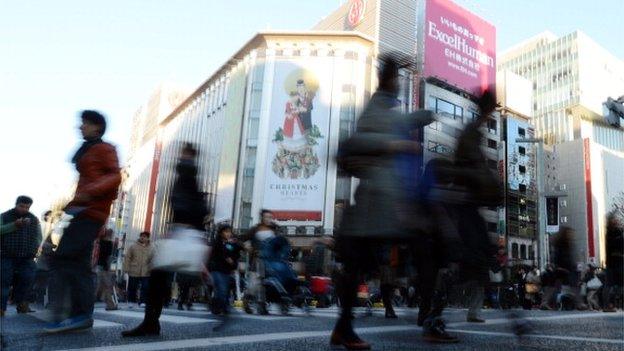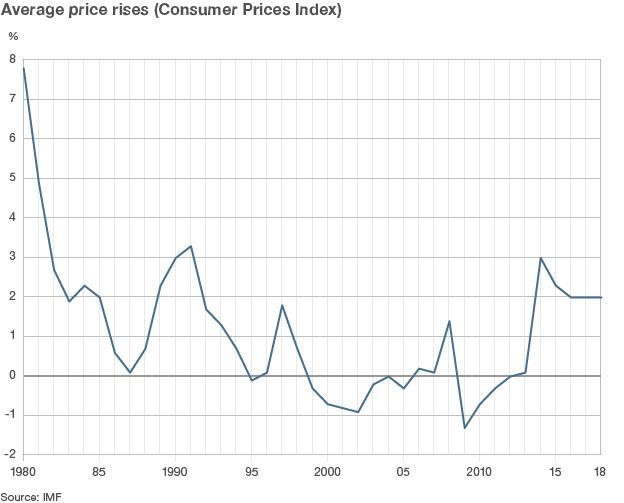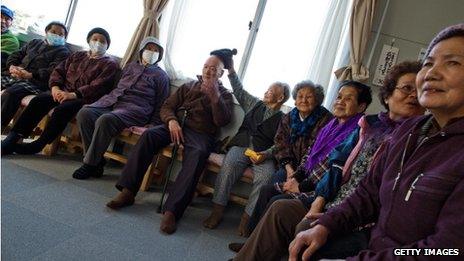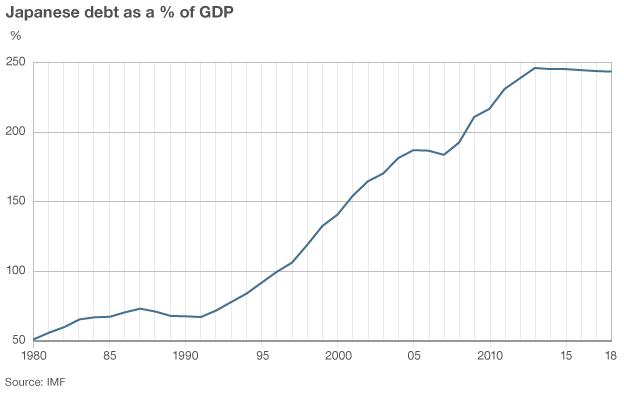Abenomics: Can it really end deflation in Japan?
- Published

The reaction of Japanese consumers to the stimulus will be crucial
The Bank of Japan is undertaking one of the most aggressive injections of cash by any central bank in the world in order to try to combat falling prices and achieve 2% inflation in 2 years.
The central bank, which holds its latest policy-making meeting on Friday, plans to expand its balance sheet to 270 trillion yen ($2.8tn; £1.8tn) by the end of 2014. This equates to about 53% of GDP or economic output in that year.
The policy is part of a bold new set of economic measures backed by Japan's Prime Minister, Shinzo Abe, known as Abenomics.
Declining prices of goods and services - deflation - discourages consumers from making purchases because they expect prices to be lower in the future.
It is a vicious cycle - as consumers delay purchases, businesses see demand fall so they postpone investment. It has contributed to a stagnant economy in Japan since the property crash in the early 1990s.
The question now is will it work? If there are three yen instead of two yen chasing each good or service produced, then surely that will raise prices?
'Bazooka'
It is not the first time that it has been tried. In 1997, the BOJ balance sheet was 50 trillion yen. It grew to three times that size a decade later and yet deflation persisted.
Deflation did cease at times, but a lack of demand for credit meant that money still was not flowing in the economy, so deflation returned once the BOJ halted its cash injections.

What is different this time? The BOJ is unlikely to end its injections prematurely since the Finance Minister Taro Aso calls the policy a "bazooka".
The government is also increasing spending to try to raise GDP by 2%. This boost to demand is designed to encourage firms to invest rather than hoard cash, another important part of ending the deflationary cycle.
There are some promising signs.
A key indicator is how consumers react. The Japanese Cabinet Office's consumer sentiment survey from last month found that nearly three quarters (71.8%) of households expect prices to rise over the next 12 months.
If consumers expect prices to rise, then they will not put off purchases and could break the vicious cycle. The IMF seems to think they will, as it estimates that inflation will be 3% in 2014, a figure that has not been seen since the real estate bubble burst more than two decades ago.
Will it work?

Japan's ageing population and slow productivity growth may undermine Abenomics
For inflation to take hold though, there must be underlying price pressure, namely from wages. If wages rise, then the prices of goods and services will rise - and are more likely to remain higher - because wage rises are hard to reverse.
But a Reuters survey found that 85% of companies planned to keep wages static or even cut them this year. And bonuses, a crucial part of take-home pay, are around the lowest level since such records began in 1990.
The sharp rise in the stock market could help lift the spirits that encourage investment. The Nikkei is up 40% since last November when Abe was mooted to win, and exceeded 13,000 for the first time since 2008. The increase raises other concerns about asset bubbles, however.
A weaker yen should also help firms to export. The Japanese currency has lost about 20% of its value against the US dollar since November. It had averaged 80 yen to the dollar last year. With the yen now closer to 100 per dollar, exports could be boosted.
On the other hand, there are other reasons why Abenomics may not work. These include a lack of underlying demand for credit and an ageing population with slow productivity growth, which does little to inspire investment.
High stakes
Japan's economy is stagnant rather than disastrous. But the effect of deflation on debt is a key reason why the stakes are so high.
Japan's government debt-to-GDP ratio exceeds 200%. One of the causes of the rise in the debt level is deflation, which increases the real value of debt.
Although the interest rate is 0% to 0.1%, average deflation of -1.3% in the past 15 years means that the real interest rate (nominal interest rate 0% minus the price change of -1.3%) is a positive 1.3%.
It is one of the reasons that public sector debt has risen rapidly - from 67% of GDP in 1990 to an estimated 245% of GDP next year - taking Japan into what the OECD describes as "uncharted territory."

The stakes for Abenomics could not be higher. And not just for Japan.
Wider implications?
If Japan's massive stimulus succeeds in ending deflation, it could have an impact on monetary policy far beyond the country.
Other central banks, including the US and UK, have been running major quantitative easing (QE) programmes for a number of years, injecting billions of dollars into their financial systems to try to kick start growth.
But so far, there is little hard evidence of the effects of QE, largely because we do not know what the situation would have been without it.
So if Prime Minister Abe's QE succeeds, and it does so through changing the inflation expectations of consumers, it will be proof of how inflationary the policy can be.
That is good news for Japan after more than a decade of falling prices. But it may not be so good for other countries who face rising, not declining prices.